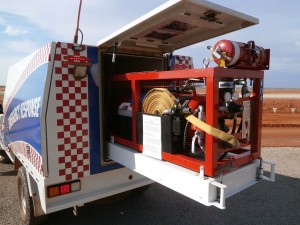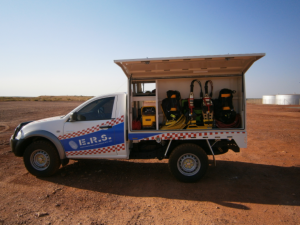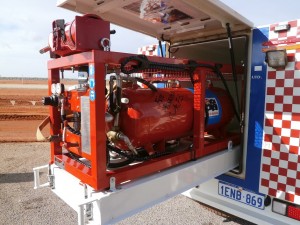Emergency services working in the remote Pilbara of Western Australia are faced with many obstacles. In August 2012, Executive Risk Solutions (ERS) took up the challenge of delivering emergency services for over 400kms of remote construction site operations with the Roy Hill Project.
For those reading this article and who are not familiar with the Pilbara region it is a large (507,896 km2), remote dry,  thinly populated region in the north of Western Australia where during the summer months maximum temperatures exceed 32 C almost every day and temperatures in excess of 45°C are not uncommon.Taking into consideration the climate and environmental conditions, ERS developed a fire appliance fleet with the capabilities of an urban or industrial fire service with the ability to work in a remote environment. The constraints for the region include isolation, climate, lack of back up, tyranny of distance, limited water, off road operations, and variety of incidents. Our resultant capability included response to structural fires, bushfires, hazmat incidents, vertical rescue, vehicle and heavy rescue.The development and delivery of this capability is described below.
thinly populated region in the north of Western Australia where during the summer months maximum temperatures exceed 32 C almost every day and temperatures in excess of 45°C are not uncommon.Taking into consideration the climate and environmental conditions, ERS developed a fire appliance fleet with the capabilities of an urban or industrial fire service with the ability to work in a remote environment. The constraints for the region include isolation, climate, lack of back up, tyranny of distance, limited water, off road operations, and variety of incidents. Our resultant capability included response to structural fires, bushfires, hazmat incidents, vertical rescue, vehicle and heavy rescue.The development and delivery of this capability is described below.
After carefully reviewing th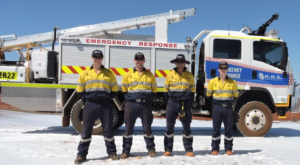 e location and the various risk scenarios the Roy Hill project may encounter, ERS came up with an innovative solution and developed a unique Rapid Intervention Vehicle (RIV). This is a purpose built 4WD light fire and rescue tender equipped with Compressed Air Firefighting Systems (CAFS).
e location and the various risk scenarios the Roy Hill project may encounter, ERS came up with an innovative solution and developed a unique Rapid Intervention Vehicle (RIV). This is a purpose built 4WD light fire and rescue tender equipped with Compressed Air Firefighting Systems (CAFS).
The CAFS is ideally suited to Western Australian conditions and was an ideal choice for the Project, with its ability to deliver compressed air generated foam for suppression or in a barrier form as a retardant.The RIV comes with multiple capabilities including: compressed air foam delivery; light and heavy rescue; breathing apparatus; HAZMAT, line rescue, medical response and minor equipment.
ERS Emergency Response crews respond to a wide range of industrial incidents to mitigate risk and maintain control. The RIV provides our crews with the ability to respond independently or commence operations prior to the arrival of the Department of Fire and Emergency Services (DFES) or other mutual aid partners.
ERS has seven RIV’s that are currently deployed across the Roy Hill construction and operational areas of the Port, Rail Camps and Mine site.
The equipment list on the RIV’s is extensive and is state of the art for ease of use and operational effectiveness.
- The equipment list includes:
- Personal Protective Clothing (PPC)
- Oxygen resuscitation equipment
- Major Trauma kit
- Defibrillator
- Firefighting equipment and firefighting hose
Compressed Air Foam Firefighting System
Compressed Air Foam Injection System
Compressed Air Foam delivery system
Foam concentrate - Road and Industrial Rescue Equipment
- Line Rescue
Lifting air bags and controllers
Hydraulic cutters, spreaders and ram
Diesel powered hydraulic power pack
Hooligan tool
Rescue stretcher - Hazardous Materials Response Equipment:
- Breathing Apparatus, and spare cylinders
- Chemical splash suits
- Emergency scene lighting
- Emergency Warning Strobes
- Rope Rescue and Haulage equipment
- Satellite communications
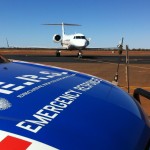 Traditionally light fire appliances carry 400 to 600 litres of water and drums of “A” and “B” Class firefighting foam. The weight of water and foam was a factor in designing the RIV’s given the range of equipment to be carried. Therefore the CAFS installation to the RIV’s became a logical choice given the advantages in suppression, weight and multiple applications for the risks of the project.The advantage of CAFS can be quantified as:
Traditionally light fire appliances carry 400 to 600 litres of water and drums of “A” and “B” Class firefighting foam. The weight of water and foam was a factor in designing the RIV’s given the range of equipment to be carried. Therefore the CAFS installation to the RIV’s became a logical choice given the advantages in suppression, weight and multiple applications for the risks of the project.The advantage of CAFS can be quantified as:
- Available water supply and personnel resources are used much more effectively;
- Compressed air foam clings well to threatened exposures;
- Less water is wasted during exposure protection applications;
- Less water also minimises water damage potential;
- Faster knock down time than water;
- Approximately 20 times less weight to carry than water systems for the same volume of output;
- Uses far less foam than aspirated systems – reducing any impact that foam may have on the environment;
- Foam clings, smothers and forms a film preventing the fire from spreading;
- Foam can be sprayed onto vertical surfaces;
- Lighter fire hose (full of foam/air not water);
- Can be used as fire retardant in bushfire operations;
- Increased operational efficiency;
- Increased fire-fighter safety; and
- Reduced property damage.
“It was an interesting process selecting a fit for purpose fire and rescue appliance fleet for the Roy Hill contract. Particularly so given the variables in service delivery in the vast operational area. Our staff and contractors who designed and built the Rapid Intervention Vehicle need to be complimented for their efforts in coming up with an innovative product. The tailored solution has given ERS crews a fast response appliance with the right amount of equipment so that on arrival they can get to work to control the situation and render assistance to injured persons and protect valuable assets” Scott Houston , CEO
The selection of a fire appliance and the equipment is always challenging for emergency response agencies and ERS believes the solution they provided with the fleet of RIV’s was right for our Roy Hill Operations.
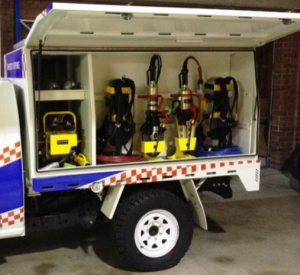 ERS’ innovative technology, processes and services have proved to be a significant solution for companies operating in high risk environments. Invaiably these companies are located in remote areas that have limitations in their emergency response solutions for what is the most important matter on site, SAFETY. ERS has now invested more than $3million in its vehicles with seven of the RIVS now on location in the Pilbara. In June last year we took delivery of a new purpose-built Fire Tender with automatic roof turret which is now located at the Roy Hill Mine.
ERS’ innovative technology, processes and services have proved to be a significant solution for companies operating in high risk environments. Invaiably these companies are located in remote areas that have limitations in their emergency response solutions for what is the most important matter on site, SAFETY. ERS has now invested more than $3million in its vehicles with seven of the RIVS now on location in the Pilbara. In June last year we took delivery of a new purpose-built Fire Tender with automatic roof turret which is now located at the Roy Hill Mine.
Contact ERS for more information on our experience with selecting emergency response appliances for your remote operations.
Phill Cribb AFSM – ERS Fire and Emergency Management Specialist



